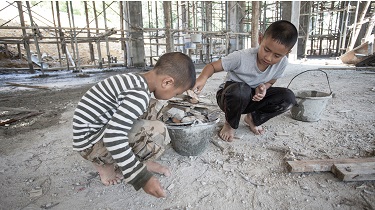Starting in January 2024, many Canadian companies will have to report in writing what they did this year to prevent or reduce forced or child labour in their supply chains.
The mandatory measures are in response to Bill S-211, the Fighting Against Forced Labour and Child Labour in Supply Chains Act, passed by Parliament in May 2023.
According to the International Labour Organization (ILO), nearly 28 million people, including children, were in situations of forced labour in 2021, an increase of 2.7 million over 2016 global estimates.
Forced labour is defined as “all work or service which is exacted from any person under the menace of any penalty and for which the said person has not offered himself voluntarily.”
This type of exploitation in the workplace is happening in virtually every country in the world, including Canada, and stretches across ethnic, cultural and religious lines.
Forced labour in global supply chains
Forced labour is found at all stages of the global business supply chain. Men, women and children may be forced to harvest crops and ingredients used in food products; extract raw materials such as minerals used in electronics; manufacture products such as textiles and clothing in factories; and deliver or ship goods. Both major and lesser-known brands can be involved.
Under the act, companies of all sizes have an opportunity and responsibility to crack down on forced labour, which has increasingly become a human rights priority for governments and business.
What are the new requirements?
The act comes into effect on Jan. 1, 2024 and has two basic requirements:
1. Companies that meet certain thresholds (described below) must annually file detailed reports on what measures they’ve taken in the previous year to prevent and reduce the risk of forced or child labour used by their company or within their supply chains. Your first report must be filed on or before May 31, 2024.
“It’s a good idea to start thinking now about what you’ll be writing about in that report,” says Awovi Komassi, an Environmental, Social, Governance (ESG) Advisory Services lead at Export Development Canada (EDC).
2. Customs tariffs will be amended to prohibit importing goods that are mined, manufactured or produced, in whole or in part, by forced or child labour as defined by the act. This can include even a small component used to make a product.
What does my report need to include?
Your report must detail the steps your company took in 2023 (and each year subsequently) to prevent and reduce the risk of forced or child labour at every step in the production of your goods—both in Canada and abroad. Other details to include about your company:
- Its structure, activities and supply chains
- Its policies and due diligence processes in relation to forced and child labour
- The parts of your business and supply chains that carry a risk of forced or child labour and the steps you’ve taken to assess and manage that risk
- Any measures taken to remediate any forced or child labour
- Any measures taken to remediate the loss of income to the most vulnerable families as a result of measures taken to eliminate the use of forced or child labour
- The training provided to employees on forced and child labour
- How your company assesses its effectiveness in ensuring that forced and child labour aren’t being used in your business and supply chains
If you’re a supplier to large companies, being able to show them your human rights policies, due diligence practices and supply chain transparency can give you a competitive advantage.
The reporting requirement for Bill S-211 applies to all Canadian companies listed on a Canadian stock exchange or that met two of the following criteria in 2023:
- Had at least $20 million in assets
- Generated at least $40 million in revenue
- Employed at least 250 employees
But Awovi Komassi, an ESG Advisory Services lead at EDC, says all companies should expect and prepare for impacts to their business.
“Some may think this only applies to large companies. But there will be a trickle-down effect as the directly affected businesses start to re-examine their supply chains and consider putting due diligence systems into place,” says Komassi.
“If you’re a supplier to large companies, being able to show them your own human rights policies, due diligence practices and supply chain transparency can give you a competitive advantage.”
Other legislation impacting Canadian companies
“Markets such as the United Kingdom and Australia have had disclosure-based legislation for some time and we’re increasingly seeing a shift towards more prescriptive due diligence-focused legislation and import bans,” says Ashley McIntyre, senior policy advisor, Human Rights & Supply Chains, with EDC’s ESG Policy & Research team.
“Some legislative proposals are applicable to companies doing business in those markets—no matter where they’re from,” McIntyre says.
…Establishing robust supply chain management systems means that you’ll be well-positioned to respond to forthcoming legislative requirements, which can help open more markets for your products—another competitive advantage.
One example is the Corporate Sustainability Due Diligence Directive in the European Union (EU). If formally adopted, it will require companies, in relation to the EU, to conduct due diligence on potential human rights and environmental considerations in a company’s operations and corporate governance. The new rules will also apply to a company’s value chains—inside and outside Europe.
Another example is the European Commission’s September 2022 proposed regulation on prohibiting products made with forced labour on the EU market. The regulation would prohibit all products made using forced labour, including child labour, in the EU for domestic consumption, and for exported and imported goods.
Closer to home, Canada’s largest trading partner, the United States, has established the Trade Facilitation and Trade Enforcement Act (TFTEA) and more recently, the Uyghur Forced Labor Prevention (UFLPA) Act. Both acts prohibit the import of products made using forced labour into the U.S. and permit the seizure of suspected goods unless companies can demonstrate through supply chain due diligence that the goods weren’t made using forced labour.
“These requirements for companies to carry out human rights due diligence across their supply chains will only increase,” says McIntyre. “Beginning to establish robust supply chain management systems means that you’ll be well-positioned to respond to forthcoming legislative requirements, which can help open more markets for your products—another competitive advantage.”
One good resource for more information is Forced Labour in Canadian Supply Chains: Responsible business conduct abroad.
Supply chain due diligence
“Even if your company doesn’t yet meet the thresholds to file a report, Bill S-211 is a perfect opportunity to start reviewing and thinking about your company’s human rights plans and practices,” says Komassi. “Obviously, combating forced and child labour is simply the right thing to do, but there are also a lot of competitive advantages for your company in doing so.”
Benefits include:
1. Consumers vote with their wallets and want to know that the goods they buy are made responsibly. Doing so can help you increase sales and enhance your brand, while being proud of how your business operates.
2. As requirements to combat forced and child labour increase globally, proactively putting your own strategies into action will make your company more competitive over those that don’t, and better able to respond to buyer requests for supply chain information.
3. Companies committed to strong ESG practices are often more resilient and less likely to experience severe disruption, precisely because they’re prepared to mitigate and manage ESG risks and impacts. “We saw this during the pandemic,” says McIntyre. “Companies that had good occupational health and safety systems in place were better equipped for business continuity.”
4. Compliance can make you more attractive to investors. Investors are increasingly screening companies’ ESG practices before making an investment decision.
5. Gaining access to capital: EDC and financial institutions have to conduct their own due diligence for ESG, so addressing your human rights risks may make it easier to access more credit.
How to get started
“A good place to begin is to examine your supply chain and conduct a risk assessment, and then put recommended strategies into place,” says Komassi. “What are three to five things you can do that will have an impact?”
But she’s quick to point out: “You don’t need to have all the answers and policies in place right now, but you can work towards a process of continuous improvement. You can also seek professional advice to help you navigate the complexities.”
You should also check out
Why respecting human rights is important for doing business—at home and abroad
On the flip side, a company may already be publishing reports on their human rights initiatives, including for forced and child labour, to comply with similar mandatory requirements in other jurisdictions abroad. “You may want to consider seeking professional advice to assess whether your existing reporting structures can be expanded to satisfy the requirements of Canada’s new act,” says Komassi.
She also suggests reviewing your regulatory obligations on a regular basis, especially when adding new products, suppliers, or markets, to see if anything needs to be added or changed.
Knowing what industries, products and regions are at higher risk for forced and child labour is key, as well as digging deeper into supply chains beyond your primary supply relationships and mapping your supply chain.
When evaluating suppliers or even your own operations, you may want to ask:
1. Have you identified key regulatory requirements, principles and guidelines that will impact your human rights risks management in your operations and supply chains? What are others in your industry doing that your company could also do?
2. Have you identified the countries and regions in which your company operates that would be considered high risk?
3. Have you identified your suppliers, subcontractors, and any other key stakeholders in each country or region?
4. Have you identified any pressing issues?
5. Do you have a system to report grievances for harassment and discrimination?
6. What human rights commitments does my company have and what expectations do we have for our suppliers?
7. How are those expectations communicated to suppliers and disseminated throughout the supply chain? What training can I provide to my employees and suppliers to help them recognize and mitigate possible forced and child labour abuses?
8. How is my company evaluating suppliers on their ability to meet our expectations?
9. How can we support suppliers in meeting these expectations?
10. What are we saying publicly as a company about our human rights-related risks, opportunities, and activities?
Communication is key and can help you gather important information. Let your employees, suppliers and customers know that preventing child and forced labour is a top priority for your company. Ask your suppliers to share their own practices and supply chains and start documenting the information.
This isn’t a once-and-done practice; provide regular updates on your progress.
“At the same time, use your own leverage and influence to encourage other companies in your supply chain to better their own practices,” says McIntyre.



